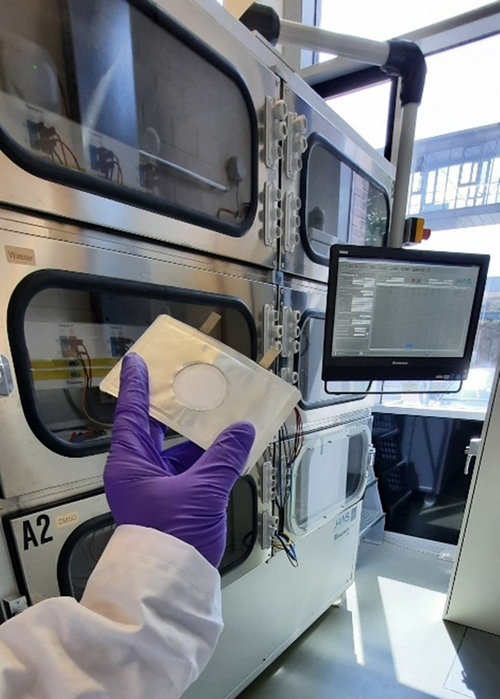The lithium-air battery, also known as a lithium-oxygen battery, is a strong contender for the next generation of high-energy electricity storage technologies. Although their theoretical energy storage capacity is ten times that of traditional lithium-ion batteries of the same weight, they are not chemically stable enough to provide a viable alternative.
 A lithium-air battery cell in front of a test bench. Image Credit: Fraunhofer IFAM.
A lithium-air battery cell in front of a test bench. Image Credit: Fraunhofer IFAM.
Now, a newly initiated collaborative research project is exploring a new concept to extend the life of these battery cells, with a team from the University of Oldenburg, Germany, directed by Professor Dr. Gunther Wittstock.
The project, titled, “Alternative materials and components for aprotic lithium-oxygen batteries: chemistry and stability of inactive components – AMaLiS 2.0,” is guided by IOLITEC Ionic Liquids Technologies, a company based in Heilbronn, Germany.
The University of Münster’s MEET (Münster Electrochemical Energy Technology) Battery Research Center and the Fraunhofer Institute for Manufacturing Technology and Advanced Materials IFAM in Bremen are also participating. The Federal Ministry of Education and Research will fund the study for three years with approximately 1.1 million euros.
Lithium-air batteries function in the same way as ordinary batteries, but the reaction of lithium ions with oxygen from the air at the positive electrode generates power. The main benefit is that lithium-air batteries can store nearly as much energy per kg as fossil fuels. This means they have a similar specific energy to today’s batteries but weigh substantially less, making them appealing for usage in both electric vehicles and stationary energy storage.
“However, before we get that far there are still a number of technical problems to be solved,” Wittstock underlines. One of these issues is the lack of chemically stable electrolytes at both the positive and negative electrodes. These conductive fluids or solids are found between the two electrodes.
Oxygen From the Air is Reduced in Lithium-Air Batteries
One electrode in a lithium-air battery is constructed of metallic lithium, while the other, known as the gas diffusion electrode, is made of a porous network and conducting material where oxygen (O2) from the air is reduced in an oxidation-reduction reaction.
During discharge, positively charged lithium ions flow through the electrolyte from one electrode to the gas diffusion electrode, where they mix with oxygen and electrons from an external electrical circuit to generate lithium oxide. This produces an electric current, which can be used to power electrical devices. During charging, lithium and oxygen separate, and the ions and electrons go in opposite directions.
To improve the lithium-air battery’s stability, the research team plans to create a membrane that divides the positive electrode from the negative electrode, allowing alternative electrolytes to be utilized on either side.
“This would significantly expand the options for electrolytes,” notes IOLITEC’s project coordinator Dr Thomas Schubert. The researchers intend to test a separator with a unique coating on both sides that will protect both the lithium electrode and the gas diffusion electrode.
The Oldenburg group, headed by Wittstock, is investigating the processes on the surfaces of the separator and electrodes using a variety of approaches, including surface spectroscopy and scanning electrochemical microscopy (SECM). IOLITEC is working on the separating layer alongside a team from the MEET Battery Research Center at the University of Münster, led by Verena Küpers.
We are testing different coatings that are specifically adapted to the challenges posed by each type of electrode.
Verena Küpers, University of Münster
The MEET team also performs test measurements. A team guided by Dr. Daniela Fenske at Fraunhofer IFAM is creating a novel form of gas diffusion electrode comprised of nanostructured titanium carbide.
It will be combined with a special membrane that prevents parasitic air components such as carbon dioxide or water vapor from entering the cell.
Dr. Daniela Fenske, Fraunhofer Institute for Manufacturing Technology and Advanced Materials
The researchers’ ultimate goal is to create a prototype that demonstrates the feasibility of a stable, rechargeable system. A flat cell with a surface size of 25 square centimeters is designed for this purpose.